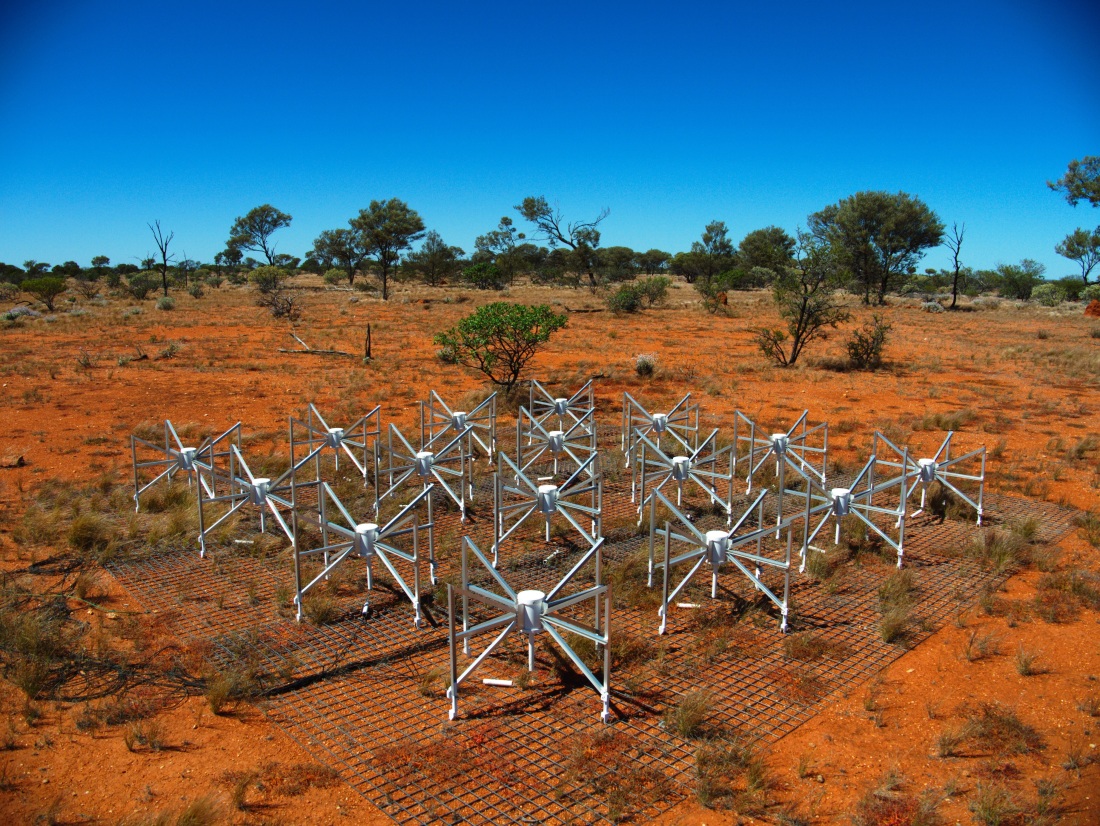
MWA aerial view of the centre of the array. AAVS1, the station of prototype SKA-low antennas, is visible at bottom left. Credit – Curtin University
24 April 2018
A major expansion of the Murchison Widefield Array (MWA), one of four SKA precursor telescopes, has been completed, doubling the number of antenna stations at the remote site in Western Australia.
The addition of 2,048 antennas will make the low-frequency radio telescope ten times more powerful as it seeks to explore the evolution of the Universe. As one of four precursors to the SKA, the MWA provides scientists with invaluable knowledge and carries out scientific study related to future SKA activities. Curtin University, based in Perth, operates the telescope on behalf of a consortium of 21 research institutions.
MWA Director Prof Melanie Johnston-Hollitt notes that the upgrade will greatly assist scientists in their research. “The telescope is now ten times more powerful and with double the resolution, meaning not only can we explore more of the Universe, but the quality of the images we produce is significantly improved, providing the opportunity for greater scientific discovery,” Prof Johnston-Hollitt said.
Australia’s Minister for Jobs and Innovation Michaelia Cash attended a celebratory event at Curtin University alongside Prof Johnston-Hollitt, SKA Organisation Director-General Prof Philip Diamond and Chair of the SKA Board of Directors Dr Catherine Cesarsky.
“The SKA will be the largest and most advanced radio telescope ever constructed and will be used by scientists from around the world to make major discoveries about the universe. Lessons learned in building and operating the MWA are vital to delivering the SKA,” Minister Cash said in a statement. “These projects are also driving the development of new technologies, particularly in the field of big data management. This work is helping to expand Australian businesses and create jobs, in Western Australia and across the country.”
Read the official press release on the Curtin University website.
See the full article here .
Please help promote STEM in your local schools.
![]()

SKA ASKAP Pathefinder Telescope

SKA Meerkat Telescope

SKA Murchison Wide Field Array
About SKA
The Square Kilometre Array will be the world’s largest and most sensitive radio telescope. The total collecting area will be approximately one square kilometre giving 50 times the sensitivity, and 10 000 times the survey speed, of the best current-day telescopes. The SKA will be built in Southern Africa and in Australia. Thousands of receptors will extend to distances of 3 000 km from the central regions. The SKA will address fundamental unanswered questions about our Universe including how the first stars and galaxies formed after the Big Bang, how dark energy is accelerating the expansion of the Universe, the role of magnetism in the cosmos, the nature of gravity, and the search for life beyond Earth. Construction of phase one of the SKA is scheduled to start in 2016. The SKA Organisation, with its headquarters at Jodrell Bank Observatory, near Manchester, UK, was established in December 2011 as a not-for-profit company in order to formalise relationships between the international partners and centralise the leadership of the project.
The Square Kilometre Array (SKA) project is an international effort to build the world’s largest radio telescope, led by SKA Organisation. The SKA will conduct transformational science to improve our understanding of the Universe and the laws of fundamental physics, monitoring the sky in unprecedented detail and mapping it hundreds of times faster than any current facility.
Already supported by 10 member countries – Australia, Canada, China, India, Italy, New Zealand, South Africa, Sweden, The Netherlands and the United Kingdom – SKA Organisation has brought together some of the world’s finest scientists, engineers and policy makers and more than 100 companies and research institutions across 20 countries in the design and development of the telescope. Construction of the SKA is set to start in 2018, with early science observations in 2020.
